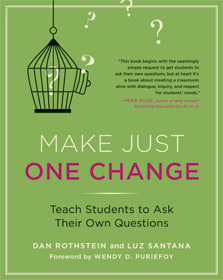Students who ask questions, who ask good questions, and who can set and follow a line of inquiry will succeed at a far higher rate than those who either do not know how to formulate their own questions or simply fail to regularly generate their own questions.
Asking questions is one of the most important skills for learning. When students learn to ask questions they become more engaged, have more ownership of their learning and learn more.
· produce their own questions
· improve their questions
· prioritize and strategize on how to use their questions
As students go through the QFT process, they practice three fundamentally important thinking abilities: divergent thinking, convergent thinking and metacognition.
Teachers have consistently reported that the QFT process helps with classroom management and allows them to facilitate a student-centered classroom. Asking questions is a transformative and transferable skill for students. Teachers help students develop an essential skill that is transferable beyond the classroom.
You are already using questions to drive your instruction by asking questions of students. The same way you can use student questions. The difference here is that you are using the questions students produce.
Each of the four rules stimulates behaviors that encourage effective and consistent question formulation skills.
The goal is for students to learn to think in questions. Answering the questions is not a main goal but part of the process is to use student questions. You or you and the students will decide what action to take, including answering the questions.
- develop a project
- independent project
- set their learning agenda
- write an essay
- research paper
- experiments
- guide a reading
- assess students knowledge
- plan a lesson
- assessment tool



